“When a girl is shooting a handgun, it’s really something. When I saw Gloria… she shoots a handgun as if she is throwing dishes. It’s really exhilarating.”
— Hayao Miyazaki
Hayao Miyazaki is the greatest animator of all time. Since his feature directorial debut in 1979, with The Castle of Cagliostro, he has been responsible for more classic movies of the form than anyone else. As of August 2018, he had six films ranked in the IMDb Top 250, the most by a non-Engliah language director, and the same number as Alfred Hitchcock. While there are many themes which have been a notable part of his work over the past four decades, perhaps the most consistent is his love of heroines. Women almost invariably stand not only front and center, but also occupying important supporting roles as well.
Frequently, but not always, these are teenagers or even younger. The characteristics they embody stand in sharp contrast to most Disney princesses of the era. For example, when Princess Mononoke came out in 1997, Disney was still offering up tepid heroines like Jasmine and Pocahontas, defined almost entirely by their looks, instead of their actions. They weren’t the ones doing the rescuing, shall we say. This is perhaps a result of the public-domain fairy tales which the media behemoth strip-mined for their movies, not exactly a source of female empowerment. In contrast, Miyazaki invents the worlds he wants. After Cagliostro, he didn’t adapt anyone else’s work for a quarter-century, until his ninth feature, Howl’s Moving Castle, in 2004.
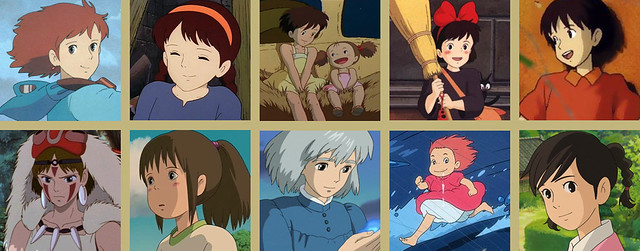
And there can be little doubt, what Miyazaki wants, are thoroughly self-reliant young women. He told The Guardian in 2013, “Many of my movies have strong female leads – brave, self-sufficient girls that don’t think twice about fighting for what they believe in with all their heart. They’ll need a friend, or a supporter, but never a savior. Any woman is just as capable of being a hero as any man.” That is a theme which runs through most of his work, even if not all are what you’d call “action heroines.” For example, it would be a stretch to label as such, Mei from My Neighbour Totoro, or the titular heroine of Kiki’s Delivery Service. While still sharing many elements with their more energetic colleagues – bravery, compassion, fidelity, smarts, and an undeniable feistiness – they’re more reactive than active.
What’s also common is an almost complete lack of “princes”. For romance, in the conventional sense, is all but absent from the Miyazaki oeuvre. Certainly, no-one is sitting around, singing about how some day their love interest will come. Miyazaki heroines are almost asexual to a fault. While entirely understandable at the younger end of the spectrum, it’s notable how even the older ones, like the 17-year-old Fio in Porco Rosso, have better things to do. This is entirely deliberate, the director saying, “I’ve become skeptical of the unwritten rule that just because a boy and girl appear in the same feature, a romance must ensue. Rather, I want to portray a slightly different relationship, one where the two mutually inspire each other to live—if I’m able to, then perhaps I’ll be closer to portraying a true expression of love.”
 Indeed, their femininity is often virtually irrelevant. Gender-wise, you could swap many of them out with young men or boys, and little would need to be changed. I’d argue it’s the most effective kind of feminism: the sort which doesn’t need to shout about it, but simply gets on with doing and being, and leads by example rather than the creation of loud noises. Yet, as we’ll see, it’s a philosophy which cuts both ways. Being female does not necessarily make you a good person: they can be every bit as egotistical, prejudiced, cruel and willing to bring down hellfire and destruction, as any man. That’s true equality in cinematic action.
Indeed, their femininity is often virtually irrelevant. Gender-wise, you could swap many of them out with young men or boys, and little would need to be changed. I’d argue it’s the most effective kind of feminism: the sort which doesn’t need to shout about it, but simply gets on with doing and being, and leads by example rather than the creation of loud noises. Yet, as we’ll see, it’s a philosophy which cuts both ways. Being female does not necessarily make you a good person: they can be every bit as egotistical, prejudiced, cruel and willing to bring down hellfire and destruction, as any man. That’s true equality in cinematic action.
His most recent feature, 2013’s The Wind Rises, diverged from his previous norm in being largely heroine-free, instead offering a loose biopic of Jiro Horikoshi, designer of the Mitsubishi Zero used by the Japanese in World War II. This was followed by another Miyazaki retirement: he has more farewell tours than Cher, but has always come back for one more feature. And so it proved, with the announcement in 2016 of How Do You Live?, though little is known of its topic. But with Miyazaki now 78 years old, time is definitely not on his side. Whenever it comes, the loss will be immense, and almost irreplaceable.
For now though, let’s appreciate his work. Below, you’ll find review of the two most relevant films in the Miyazaki filmography to this site, Nausicaa of the Valley of Wind and Princess Mononoke. Despite being separated by thirteen years, they share a strong common theme of environmentalism, and also represent the Miyazaki heroine and villainess at their most well-developed.
Nausicaä of the Valley of the Wind
By Jim McLennan★★★★½
“The wind rises.”
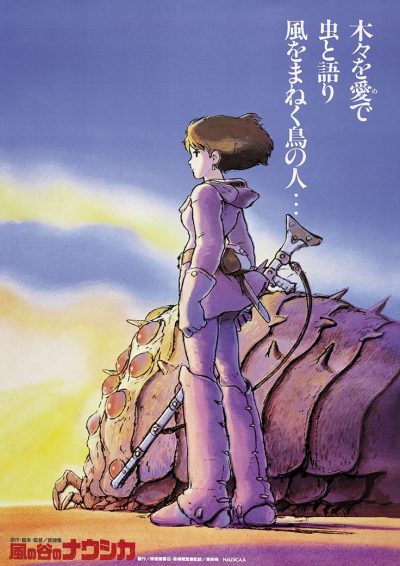
 After the enormous critical, if not commercial, success of Lupin III: Castle of Cagliostro, Miyazaki was commissioned to create a manga series for Animage magazine, with a potential film adaptation attached. Publication began in early 1982, but it would take a dozen years, albeit of intermittent publication, before that story was complete. When the series’s popularity among Animage readers was established, work began on the film adaptation, covering the early portion of the manga. Since this was before Miyazaki’s own Studio Ghibli was founded, an external company, Topcraft, were commissioned to create the animation. The budget was only $1 million, with a mere nine-month production schedule leading up to its release in March 1984.
After the enormous critical, if not commercial, success of Lupin III: Castle of Cagliostro, Miyazaki was commissioned to create a manga series for Animage magazine, with a potential film adaptation attached. Publication began in early 1982, but it would take a dozen years, albeit of intermittent publication, before that story was complete. When the series’s popularity among Animage readers was established, work began on the film adaptation, covering the early portion of the manga. Since this was before Miyazaki’s own Studio Ghibli was founded, an external company, Topcraft, were commissioned to create the animation. The budget was only $1 million, with a mere nine-month production schedule leading up to its release in March 1984.
It takes place on a post-apocalyptic world, a thousand years after the near-mythical “Seven Days of Fire”, pushed humanity to the edge of extinction. Since then, nature has taken over much of the planet, covering it in an expanding toxic jungle where the very air is poisonous in a few minutes. It is populated by equally lethal creatures, at the top being the “ohmu”, gigantic insectoids capable of destroying anything in its path. The human race is reduced to clinging on to the fringes, such as the small kingdom of the Valley of the Wind, in which a never-ending breeze keeps the toxins at bay. There, the king’s daughter, Nausicaä (Shimamoto), is one of the few brave enough to enter and explore the jungle, and has developed a mutually respectful relationship with its strange inhabitants.
The balance is destroyed when a plane from the kingdom of Tolmekia crashes. In its cargo is an enormous “God Warrior” – one of those which carried out the Seven Days of Fire – recently dug out from where it had been buried. Tolmekia and their rivals, Pejite, are wrestling for control of the warrior and the power it wields, and the crash drags the Valley of the Wind into their conflict. In particular, Princess Kushana of Tolmekia (Sakakibara) intends to use the warrior to destroy the jungle and restore mankind’s dominion over the planet. Nausicaä is ferociously opposed to this scheme, especially after discovering that the jungle is actually purifying the atmosphere and soil, absorbing the toxins from the apocalypse. She’ll do anything to stop Kushana, including being willing to sacrifice her own life if necessary.
There’s a lot going on here, as you can see. It’s somewhat understandable why, when initially shown in the West (one of the first examples of anime to receive a theatrical release), 22 minutes was cut out, in order to market it as a children’s film, retitled Warriors of the Wind. The problem is, like almost all of the director’s work, it is not a children’s film. This is not a uncommon mistake – presumably based on them having a child as the central characters, and because they’re animated, which still largely equates to Disney in many people’s minds. But they’re more about that age capturing an innocent and idealistic mentality. This is undeniably mature and thoughtful cinema. In just his second feature, and first original film, Nausicaä establishes several themes which would run through almost all of Miyazaki’s future work, in varying degrees: the joy of flight, concern for the environment, and a strong female presence.
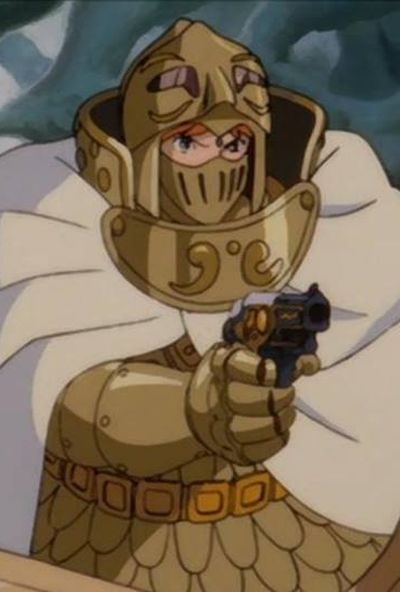 Miyazaki’s father ran an airplane parts company in World War II, and even his film company, Studio Ghibli, was named after an Italian plane. Almost every one of his movies includes a flying sequence, and Nausicaä certainly has plenty of them, whether its the heroine skimming across the desert on her one-person glider, or gigantic warships looming, threateningly, in the sky. Despite the imperfect animation, a result of the limited resources, the sense of wonder and awe is undeniable. If you don’t want to take to the skies after seeing these scenes, you might want to check for a pulse. Similarly, there’s no denying Miyazaki is firmly on the side of nature, with his heroine believing all life to be sacred, and humanity deserving no special place above any other species. If mankind can’t live in harmony with the world, the movie suggests, it’s mankind which needs to change. Bending nature to our will is always going to backfire.
Miyazaki’s father ran an airplane parts company in World War II, and even his film company, Studio Ghibli, was named after an Italian plane. Almost every one of his movies includes a flying sequence, and Nausicaä certainly has plenty of them, whether its the heroine skimming across the desert on her one-person glider, or gigantic warships looming, threateningly, in the sky. Despite the imperfect animation, a result of the limited resources, the sense of wonder and awe is undeniable. If you don’t want to take to the skies after seeing these scenes, you might want to check for a pulse. Similarly, there’s no denying Miyazaki is firmly on the side of nature, with his heroine believing all life to be sacred, and humanity deserving no special place above any other species. If mankind can’t live in harmony with the world, the movie suggests, it’s mankind which needs to change. Bending nature to our will is always going to backfire.
But it’s with the depiction of womankind that the film truly succeeds. In Nausicaä and Kushana, you have two fully-formed characters that are not just among the best in animated film, they could stand beside the protagonist and antagonist of most live-action movies. The latter, in particular, demonstrates Miyazaki’s skill at depicting those who would be flat-out villains in less nuanced films, instead being given motivation and depth. While you may not agree with Kushana resurrecting the God Warrior, you can understand what she is trying to accomplish. Her actions stem from a genuine belief that what she is doing is best for the future of mankind. She just has a military-industrial approach to that, in sharp contrast to the one emphasizing ecological science and harmony, preferred by Nausicaä. Interesting to note that, in the 2005 Disney English-language dub, Kushana was voiced by Uma Thurman.
The story here builds to a stellar climax, in which a massive herd of ohmu are lured into a stampede towards the valley, while simultaneously the God Warrior is unleashed by Kushana, to horrific effect. [The animation for the latter was done by a young Hideki Anno, who’d go on to become a master of the genre himself, best known for Neon Genesis Evangelion. In a 2006 Japanese poll, Evangelion was the only anime ranked ahead of Nausicaä as an all-time favourite] Our heroine puts herself in harm’s way in an effort to stop the carnage, and… Well, I won’t spoil it in detail; Miyazaki manages to pull off an ending which could easily have come off as contrived or ridiculous, and is instead emotionally satisfying. With even the Tolmekians forces humbled by nature, as environmental messages delivered by teenagers go, it’s certainly a great deal more effective than an angry Scandinavian shrieking “HOW DARE YOU!” at the audience.
Dir: Hayao Miyazaki
Star (voice): Sumi Shimamoto, Gorō Naya, Yōji Matsuda, Yoshiko Sakakibara
Princess Mononoke
By Jim McLennan★★★½
“Princess Die”
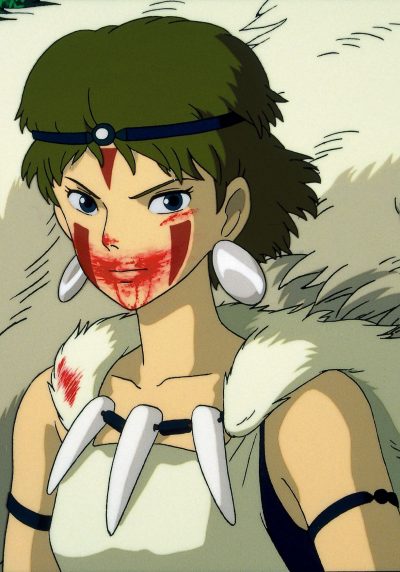 To some extent, this was the film which “broke” Miyazaki in the West, being his first feature to receive an unedited theatrical release in America. It wasn’t a huge commercial success, taking only about $2.4 million in North America. But it was very well-received, Roger Ebert listing it among his top ten films of 1999. It likely opened the door for the success of Spirited Away, which would win Miyazaki the Oscar for Best Animated Feature at the 75th Academy Awards. But if I’m being honest, I don’t like it as much as many of his movies. While there’s no denying the imagination and enormous technical skill here, it doesn’t resonate emotionally with me in the same way. I think it’s probably the central character, who is relatively bland and uninteresting, even compared to other characters in the movie.
To some extent, this was the film which “broke” Miyazaki in the West, being his first feature to receive an unedited theatrical release in America. It wasn’t a huge commercial success, taking only about $2.4 million in North America. But it was very well-received, Roger Ebert listing it among his top ten films of 1999. It likely opened the door for the success of Spirited Away, which would win Miyazaki the Oscar for Best Animated Feature at the 75th Academy Awards. But if I’m being honest, I don’t like it as much as many of his movies. While there’s no denying the imagination and enormous technical skill here, it doesn’t resonate emotionally with me in the same way. I think it’s probably the central character, who is relatively bland and uninteresting, even compared to other characters in the movie.
Firstly though: no, there’s no-one called “Mononoke” in this. It’s not a name, but a Japanese term describing a supernatural shape-shifting creature. Though even this seems ripe to cause confusion, because there are no shape-shifting princesses to be found either. And despite the title, the protagonist is Ashitaka (Matsuda), a prince of the Emishi tribe in medieval Japan, whose arm becomes infected after an encounter with a demon-possessed wild boar. As happens… Seeking a cure before the rest of his body follows suite, despite the superhuman strength it gives him, Ashitaka heads into the Western lands, and straight into the middle of an ongoing battle.
On one side is Lady Eboshi (Tanaka), the ruler of Irontown, a progressive and industrial settlement, in need of the resources which can be found in and under the nearby forest. On the other is San (Ishida), a young woman raised by wolves, who has vowed to protect the woods and their inhabitants, including the Great Forest Spirit. It’s their conflict which is really the core of the film, with Ashitaka’s quest to get his demonic arm fixed, taking a back-seat for most of the (lengthy, at 133 minutes) running-time here. Probably for the best, since he is, as mentioned, perhaps the least charismatic or engaging protagonist in the entire Miyazaki canon. His arm is easily the most interesting thing about him – and that keeps wanting to strike out on its own. When your own limb wants to go solo, you might be the problem… To quote Lady Eboshi, “I’m getting a little bored of this curse of yours, Ashitaka. Let me just cut the damn thing off.” #ImWithTeamEboshi
But enough of him. Let’s focus on what works here, which would be San and Eboshi. The first time we see San, her face is smeared in blood which she has sucked up and spat out, from a wound in the side of a gigantic white wolf. [This is certainly the most hardcore of Miyazaki’s films, with decapitations and limbs being lost at a rate closer to an entry in the Lone Wolf & Cub franchise.] She’s relentlessly aggressive in attitude, going so far as to stage a one-woman assault on Irontown in an attempt to assassinate her enemy. She tells Ashitaka, “I’m not afraid to die. I’d do anything to get you humans out of my forest.” That said, she’s still considerably less creepy than the forest apes who want to eat him.
Eboshi, on the other hand, is a complete contrast to the near-feral San, and remarkably progressive, especially considering the era and location. Her town is a haven for the disenfranchised and those society considers “untouchables”, including both lepers and prostitutes, the latter whose contracts she bought out and who now work in her iron mill. Her citizens and their welfare are what she cares about, above all, and she’s completely fearless about who she has to go through for that purpose. “She’s not even afraid of the gods, that woman,” says one of Irontown’s residents about their ruler, admiringly. They aren’t wrong, for she subsquently tells her warriors, “I’m going to show you how to kill a god, a god of life and death. The trick is not to fear him.” It’s remarkably easy to envisage a version where the roles are reversed, and she is the heroine. The fact she’s a gun enthusiast, is just a bonus!
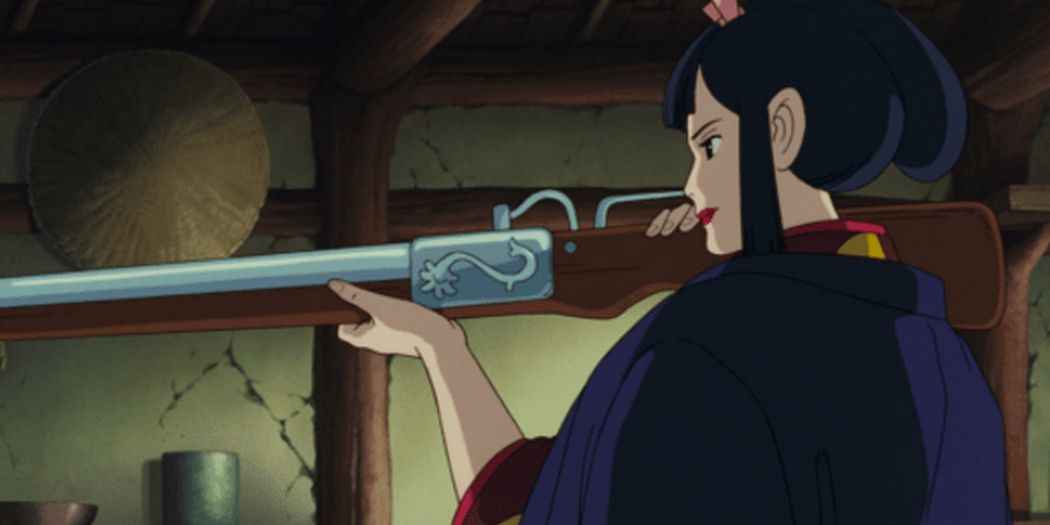
Ashitaka’s role is largely to act as a middleman between the two worlds: somewhat more than human, yet less than divine. That remains the case even at the end, as he agrees to spent part of his time in the forest with San, and part of it working alongside Lady Eboshi in Irontown. It’s potentially an awkward and unsatisfying compromise, storywise, yet Miyazaki makes it work better than you feel it should. But there are a couple of perplexing missteps too. For one, when the animals of the forest are talking, there’s zero effort to make their lips synch up. It’s bizarre and distracting. And in the Japanese version, the voice of San’s wolf mother, Moro is a man. Someone known in Japan as a drag queen, admittedly – but a man none the less, a weird choice which confused the heck out of me [score one for the dub, at least, which had Gillian Anderson as the character]
The overall result is undeniably beautifully animated, and epic in its scope and invention. As ever, Miyazaki excels at creating a world which is like our own, yet simultaneously completely alien. However, it all gets rather wearing, especially at the length depicted here. My attention simply ran dry during the second half, as the multiple different factions began hacking or gnawing away on each other, with the personal and intense quality of the Eboshi/San conflict getting lost in the bigger picture. It’s in putting over the intensely personal elements of large stories, that Miyazaki is unsurpassed – never mind just in animation, among film-makers as a whole. This isn’t the best demonstration of his talents in that area.
Dir: Hayao Miyazaki
Star: Yōji Matsuda, Yuriko Ishida, Yūko Tanaka, Kaoru Kobayashi




